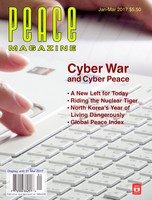
Peace Magazine Jan-Mar 2017, page 6. Some rights reserved.
Search for other articles by Janet Nicol here
Is the world becoming more dangerous? The answer is a qualified ‘yes’, according to research results of the Institute for Economics and Peace (IEP), a non-profit think tank based in Australia.
“The world is getting less peaceful,” says IEP Director Michelle Breslauer in a Skype interview from a New York office, “but that’s based on the time period we have been measuring. Since 2008 we have seen a decline in peace—not throughout history. That’s an important qualification to make.”
The Institute established an annual Global Peace Index (GPI) ten years ago, measuring negative peace in countries around the world using 23 indicators related to levels of militarization, societal safety and security and on-going conflicts. “Those 23 indicators are really looking at fear or direct violence,” Breslauer says.
According to the 2016 report, Iceland is ranked as the most peaceful country among 163 independent states and territories and Syria, the least. Canada is in eighth place.
The world has been less violent since the end of the Second World War but the report points to an increase in conflict and violence over the last decade, which is either a temporary reversal or the start of a new longer-term trend.
“A second thing to note,” Breslauer says, “is when we see this decline, it’s global but that doesn’t mean its even around the world. So another trend that we’ve also seen is that peacefulness is becoming more unequal.”
The gap between countries with high levels of peacefulness and low levels is widening. “So in the same way we think about income inequality,” Breslauer says, “we are starting to see an inequality in peacefulness as well.”
She notes 81 countries improved in their levels of peacefulness and 79 countries deteriorated. This means more countries improved, “but the deteriorations were larger and that’s what drove down the global decline.”
The deteriorations were primarily in the Middle East and northern Africa. “If you took that region out of the GPI, then you would actually see the world becoming more peaceful.”
Terrorism increased dramatically with 80 percent more deaths from terrorism around the world in 2015 than in the previous year and nine times more deaths from terrorism in 2014 than in the year 2000. Battle deaths reached a 25-year high. “In 2010 for instance, there were internal conflicts in 31 countries and that was up to 40 countries in 2014,” Breslauer says. “We saw the political instability increase and the number of refugees and Internal Displaced Persons (IDP) double. So when we look at the Middle East and northern Africa you see many countries embroiled in more intractable conflicts.”
A driving factor is the displacement of over 60 percent of Syria’s population. Countries like Yemen, Libya and Bahrain have had greater political instability and internal conflicts. Such conflicts are lasting longer, she says, and spreading throughout the region. The Institute calculates the global cost of violence has been over 13 trillion dollars.
“We also work on a framework around positive peace,” Breslauer says, “which looks at the attitudes, institutions and structures that help sustain lower levels of violence and increase peace.” The framework includes factors such as acceptance of the rights of others, equitable distribution of resources, well functioning government and low levels of corruption.
“Countries with higher levels of positive peace tend to be more resilient to both external and internal shocks.”
Iceland, for example, withstood the impact of the economic financial crisis much better than many countries. In contrast, countries with low levels of positive peace have suffered higher fatalities when natural disasters occur. “So it relates to the infrastructure and social cohesion of a country,” Breslauer says.
The Institute recently held a workshop for Ugandan youth, with the assistance of Rotary International. Participants covered topics such as high- functioning governments and acceptance of the rights of others with the goal of developing an initiative or investing in a project to strengthen positive peace in their communities.
Another IEP project involves influencing policy makers in Mexico. “For three years we measured peace within the country, state by state, across the 32 states,” Breslauer says. “We looked at seven internal indicators around organized crime, impunity, homicides, incarceration, police, violent crime and access to weapons.” The Institute developed state profiles and partnered with a civic council in Nuevo Leon state, which includes the industrial city of Monterrey, affected by the drug war and organized crime.
“Monterrey in particular, experienced great declines in peacefulness from about 2008 onward. That’s been levelling out a bit but it was very impacted,” Breslauer says. “The new governor declared as one of his initiatives to increase the rank of the state and the score in the Mexico Peace Index—that is, he wanted to improve levels of peacefulness.”
The Institute has also worked closely with the United Nations to produce sustainable development goal #16, promoting peaceful, just and inclusive societies. Breslauer says the Institute can assist countries so they can provide their own reports.
“Many countries are severely lacking in the statistical and data capacity needed to measure these factors,” Breslauer says, “even something like homicide.”
The UN is trying to increase investments in their peacebuilding fund, using the Institute’s data to argue the cost of peace is only two percent of the cost of conflict. Humanity is facing challenges unlike those of the past, Breslauer notes, such as climate change and overpopulation. “Without a certain level of peacefulness, we won’t be able to have international co-operation.”
“We want the general public to understand—and not just policy makers or practitioners in the peace-keeping field—peace is something real and can be worked towards.”
Janet Nicol is a BC educator and peace activist.
The Global Peace Index is available online at economicsandpeace.org.

Peace Magazine Jan-Mar 2017, page 6. Some rights reserved.
Search for other articles by Janet Nicol here